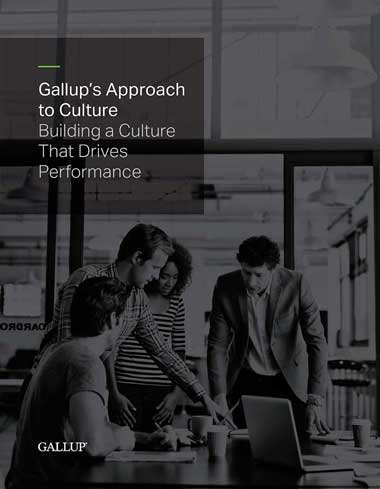Story Highlights
- A lot of restaurants are in a slump because of the saturated market
- The six points on The Golden Thread create a growth template for leaders
- Creating an effective culture will help you successfully achieve growth
This is the seventh and final article in our series for restaurant leaders about The Golden Thread, Gallup's strategy for getting ahead of your restaurant competition. Read the first, second, third, fourth, fifth and sixth articles in this series.
Strategizing external influences effectively is the sixth and last point on The Golden Thread. When this point is approached effectively, and the other five points of The Golden Thread are optimized, industry leaders can better translate the brand to new markets and uncover innovative products and services.
All six points on The Golden Thread apply to specific food service issues -- labor, management, customers -- but they're all, at heart, about culture. When food service leaders get culture right, everything else gets easier or better, often both. The Golden Thread -- and the culture it helps leaders build -- can help you translate your brand to new people and markets. It is a proven way to leverage partners outside of your organization, your employees within, and to accomplish your goals more effectively than you have before.
So yes, the points on The Golden Thread, approached holistically, help restaurants succeed in their markets, generate profit and plug revenue leaks by helping leaders create a culture that wins. But if handled with some forethought, The Golden Thread can also be used as a means for growth. So the sixth point is about bringing all the points on the thread together to solve one of the industry's biggest challenges: In tight markets like these, how can we grow?
In fact, there may be no better template for growth in food service than The Golden Thread, and a lot of brands need that template now. In a year characterized by less-than-thrilling growth (Zacks Equity Research describes it using words like soft, weak and dull), many companies need to grow their way out of the slump.
The Template for Restaurant Growth, Point by Point
Like The Golden Thread itself, growth plans should begin with vendors and suppliers. Local expertise will be invaluable, and suppliers can usually do more than they're asked. Vendors and suppliers must feel like real partners in order to think on behalf of the brand. A partnership between you and your suppliers/vendors can help you enter new markets, gain knowledge and avoid mistakes.
Franchisees and brokers who feel emotionally attached and psychologically invested are better brand ambassadors and more liable to practice the behaviors that engage employees.
HQ is the second point on The Golden Thread -- and HQ's priority is to establish the brand purpose. That purpose must be sacrosanct across stores, channels and delivery methods. Especially when the brand takes its show on the road: purpose drives the brand experience, and there's no way to provide a consistent brand experience if the purpose is too flexible.
Successful growth depends a lot on good field support, the third point. The translator between HQ and the front line, field support can and should explain to stores how products and services meet the market -- and explain to HQ what the market is saying to the stores. And when a brand is opening new locations in new territories, field people can arbitrate consistency. Sure, a brand has to accommodate places and people -- there's a reason KFC sells egg tarts at in China but not Chicago -- but culture, purpose and promise should never change. Field support's job is to make sure of that.
The fourth point on the Golden Thread is brand ambassadors. Typically, customer-facing employees are thought of as brand ambassadors because they deliver the brand promise and create the brand experience. They'll only do it if they're engaged, though, so employee engagement should be institutionalized by HQ and field support, driven by managers and felt by every employee. Their engagement is the key to capturing new customers.
But brokers and franchise owners need to be brought into the engagement fold, too. Franchisees and brokers who feel emotionally attached and psychologically invested are better brand ambassadors and more liable to practice the behaviors that engage employees. That can have a long-term competitive advantage in attracting more franchisees -- and potentially better ones -- down the road. That is the key to sustainable growth, especially when a brand is growing beyond a familiar market.
The fifth point is customers, as well it should be. To thrive in a competitive landscape, restaurant leaders must care deeply about customer engagement. To thrive in a new competitive landscape, leaders should live by it. Gallup's CE3 customer engagement survey helps restaurants move past the rational NPS metrics and lay claim to the emotional level of customer attachment. That's key to successful growth. Novelty wears off fast, and familiarity exerts a gravitational force on customers. The only way to find and keep new customers is to offer an emotionally satisfying experience more powerful than comfortable old familiarity.
Strategizing external influences effectively is the sixth and final point on The Golden Thread. When this point is approached effectively, and the other five points of The Golden Thread are maximized, restaurant leaders are positioned to achieve. They have an industry-specific, tested means of strategic execution and people management. And leaders need every bit of it to grow the brand in today's super-competitive food service market.
Execute Growth Successfully in a Saturated Market
In the past decade or so, successful growth and market penetration initiatives were based on either differentiation -- mostly healthier menu options and fast casual -- and expansion into foreign markets: Most of Wendy's net growth this year was in international markets, McDonald's and Yum! Brands overseas' sales handily beat its domestic ones -- in fact, KFC sales in China outpaced U.S. sales by nine percentage points.
The companies with the financial and human bandwidth to expand well are succeeding. But 48% of industry leaders run small shops with nine employees or fewer. They're competing with global brands that sit on massive budgets and have a margin for error that smaller operations can't muster.
But all restaurants, big or small, are facing the same problem: merciless competition in a saturated market with customers who don't even have to leave home to get a comparable product.
Because when you come right down to it, it doesn't matter to a customer who owns the place. It only matters how the place feels.
Restaurants can grow if they execute culture more intentionally. Define purpose, align it with brand promise, deliver a consistent brand experience, differentiate your brand and engage customers.
As Gallup has found with many of our clients, the dollar value of better execution, from higher productivity to increased customer engagement, can be extraordinary. When all of this is done right, getting the right talent in your doors isn't something you have to worry about anymore.
That's as true for a one-person operation as it is for a global dominator. Because when you come right down to it, it doesn't matter to a customer who owns the place. It only matters how the place feels. To thrive in this business, restaurant leaders need to follow The Golden Thread -- there are many, many aspects of a winning customer experience and The Golden Thread helps leaders strategize.
But they'll find that the thread ends where it begins: culture. When leaders in this industry are clear on culture, decisions can be easier to make, opportunities are easier to seize and mistakes may be easier to avoid. When that winning culture is in place, growth is more achievable ... and for masters of culture execution, perhaps inevitable.
Start building your strategy around The Golden Thread today:
- Get human-centric advice for your guest-centric business.
- Download our culture perspective paper and visit our customer centricity page to learn more.
- Partner with us to make culture, customer engagement and employee engagement central to your business strategy.
- Subscribe to the Gallup Access platform to get all of our customer engagement and employee engagement surveys and insights.




